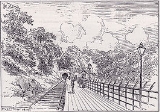
Hotwells Halt railway station
Encyclopedia
Hotwells Halt railway station, also known as the Hotwells Extension Platform, was a railway station situated in the suburb of Hotwells
in Bristol
, England
. It was on the Bristol Port Railway and Pier
line which ran between Avonmouth and . The station opened in 1917, and closed in 1922.
at the northern end of the platform. It was constructed in 1917 by the government-controlled Great Western
and Midland
railways as a wartime expedient, since workmen's trains were too long for the platform at the terminus. Some 2,000 dockworkers
each day would travel by tram to the terminus, then walk along the riverside to reach Hotwells Halt, where they would buy tickets for Avonmouth. There were two ticket booths, a small one just for Avonmouth tickets, and a larger one for other destinations. Return tickets were valid to Hotwells or , and so after the morning rush few passengers used the halt. The first two services of the day would start at Hotwells Halt, with one return terminating there.
From September 1921, the Halt was the terminus of the BPRP line, as the Hotwells terminus was closed to allow construction of the A4 Portway
. Hotwells Halt, and the line to Sneyd Park Junction, closed on 3 July 1922, with the final train running on 1 July.
Hotwells
Hotwells is a district of the English port city of Bristol. It is located to the south of and below the high ground of Clifton, and directly to the north of the Floating Harbour. The southern entrance to the Avon Gorge, which connects those docks to the sea, lies at the western end of Hotwells. The...
in Bristol
Bristol
Bristol is a city, unitary authority area and ceremonial county in South West England, with an estimated population of 433,100 for the unitary authority in 2009, and a surrounding Larger Urban Zone with an estimated 1,070,000 residents in 2007...
, England
England
England is a country that is part of the United Kingdom. It shares land borders with Scotland to the north and Wales to the west; the Irish Sea is to the north west, the Celtic Sea to the south west, with the North Sea to the east and the English Channel to the south separating it from continental...
. It was on the Bristol Port Railway and Pier
Bristol Port Railway and Pier
The Bristol Port Railway and Pier was a railway in Bristol, England.-Route:...
line which ran between Avonmouth and . The station opened in 1917, and closed in 1922.
History
Hotwells Halt was built alongside the River Avon, just north of Portnalls Number One Railway Tunnel, a few hundred yards from the main terminus at . The station had a single 700 feet (213.4 m) timber platform, a run-around loop and a siding, all controlled by a signal boxSignal box
On a rail transport system, signalling control is the process by which control is exercised over train movements by way of railway signals and block systems to ensure that trains operate safely, over the correct route and to the proper timetable...
at the northern end of the platform. It was constructed in 1917 by the government-controlled Great Western
Great Western Railway
The Great Western Railway was a British railway company that linked London with the south-west and west of England and most of Wales. It was founded in 1833, received its enabling Act of Parliament in 1835 and ran its first trains in 1838...
and Midland
Midland Railway
The Midland Railway was a railway company in the United Kingdom from 1844 to 1922, when it became part of the London, Midland and Scottish Railway....
railways as a wartime expedient, since workmen's trains were too long for the platform at the terminus. Some 2,000 dockworkers
Avonmouth Docks
The Avonmouth Docks are part of the Port of Bristol, in England. They are situated on the northern side of the mouth of the River Avon, opposite the Royal Portbury Dock on the southern side, where the river joins the Severn estuary, within Avonmouth....
each day would travel by tram to the terminus, then walk along the riverside to reach Hotwells Halt, where they would buy tickets for Avonmouth. There were two ticket booths, a small one just for Avonmouth tickets, and a larger one for other destinations. Return tickets were valid to Hotwells or , and so after the morning rush few passengers used the halt. The first two services of the day would start at Hotwells Halt, with one return terminating there.
From September 1921, the Halt was the terminus of the BPRP line, as the Hotwells terminus was closed to allow construction of the A4 Portway
Portway, Bristol
The Portway is a trunk road, approximately long, which links central Bristol, England, with its port at Avonmouth. It is part of the A4 road, which was the primary east west highway in Southern England before the construction of the M4 motorway....
. Hotwells Halt, and the line to Sneyd Park Junction, closed on 3 July 1922, with the final train running on 1 July.

